APC member Bytes for All Pakistan has just released the first study on hate speech online in the country. More than 92% of Pakistani users encountered hate speech online, and more than 51% identified themselves as targets of such speech, a survey included in the study revealed. Read more about the issue from both a quantitative and qualitative perspective.
The research included two independent phases: a ) an online survey responded by 559 Pakistani internet users, and b) content analysis of published material and comments – both textual and iconographic – on high impact, high reach social media and accounts frequented by local audiences.
Here’s a summary of the main findings from the online survey:

Results from the online survey indicated that Pakistani internet users were largely unaware of hate speech laws in Pakistan, but were, in general, largely able to identify hate speech correctly.
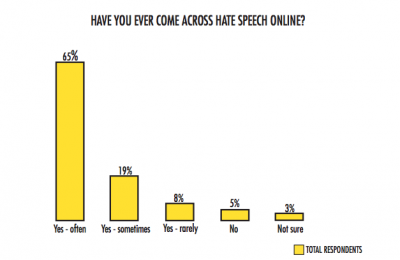
In total, 92% of respondents replied “yes” to having come across hate speech online, with 65% indicating they encountered hate speech “often”. Only 5% of total respondents said they had not encountered hate speech online.

Over half (51%) of the respondents indicated they had been the target of hate speech online.
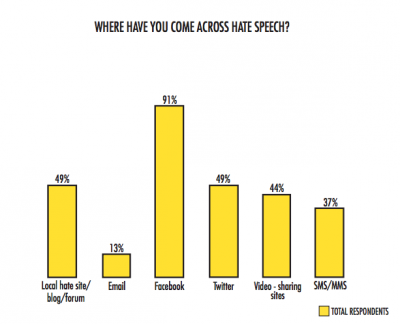
The vast majority of total respondents indicated they had come across hate speech on Facebook (91%). Facebook was the only network/medium where more than half of respondents indicated they had encountered this kind of speech.
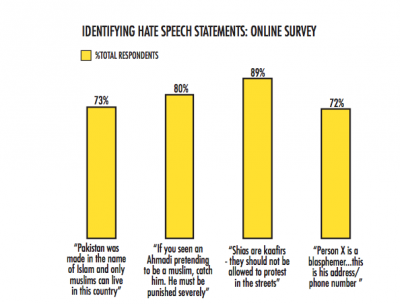
In order to determine how well respondents were able to identify hate speech, a list of statements was presented, from which respondents had to check off all the statements they personally believed constituted hate speech.In all, the highest percentage (89%) of respondents correctly identified hate speech terming followers of Shia Islam ‘kaafirs’ i.e. unbelievers/infidels. A majority of correspondents identified hate speech that targeted members of the minority Ahmadiyya religious group (80%), declared Pakistan a country for Muslims only (73%) and labeled an individual a blasphemer with his personal information attached (72%).
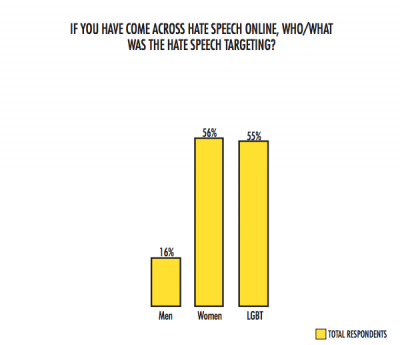
Women (56%) and LGBT (55%) were identified as main targets of hate speech. 16% of respondents said men were targets too.
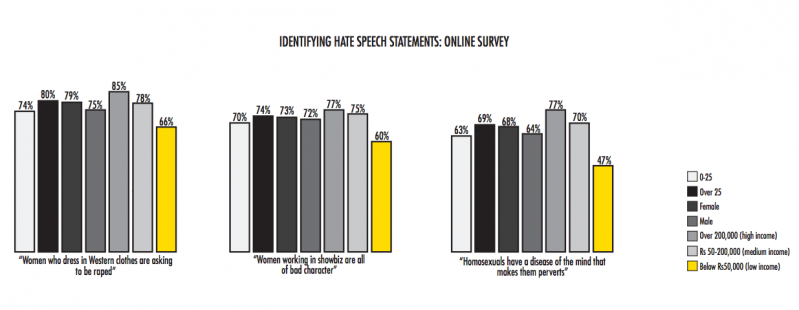
A majority of respondents correctly identified hate speech related to women and homosexuals, however, there was a significant percent- age (34%) of respondents who did not identify that saying homosexuals “have a disease that makes them perverts” was hate speech.
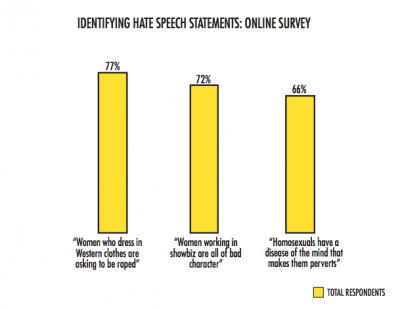
Respondents were asked to identify whether the statements, “Women who dress in Western clothes are asking to be raped” and, “Women working in showbiz are all of bad character” qualify as hate speech. In the case of the former, 77% of respondents identified the statement as hate speech, and 72% said the same of the latter. Fifty six per cent of total respondents indicated they had come across hate speech related to women.
They were also asked to identify whether, “Homosexuals have a disease of the mind that makes them perverts” qualified as hate speech. A total of 66% of respondents believed this statement to be hate speech. Respondents in the low income bracket had less than half (47%) the statement as hate speech. Fifty five per cent of respondents said they had encountered hate speech related to the LGBT community.
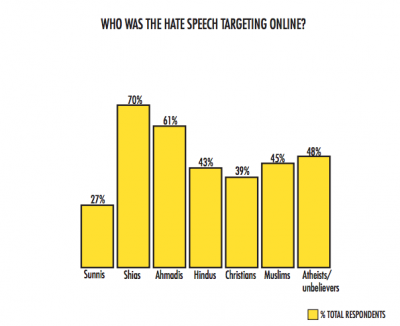
Among religious targets, total respondents indicated that hate speech against Shias (70%) and Ahmadis (61%) was markedly high.
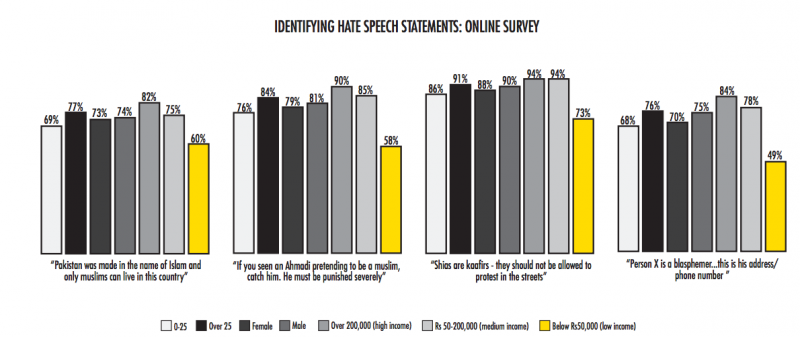
Respondents were asked to identify whether they believed the statement, ““If you see an Ahmadi pretending to be Muslim, catch him. He must be punished severely,” qualified as hate speech. Eighty per cent of respondents identified this statement as hate speech. Those in the low income bracket identified this statement as hate speech markedly less than the average (58%). When asked which group they had seen hate speech against online, 61% of total respondents indicated they had seen hate speech related to Ahmadis, second only to Shias (70%).

In terms of foreigners, the main targets identified by respondents were Jews (57%), Americans (51%) and Indians (51%).
Here’s a summary of the main findings from Facebook and Twitter analysis:
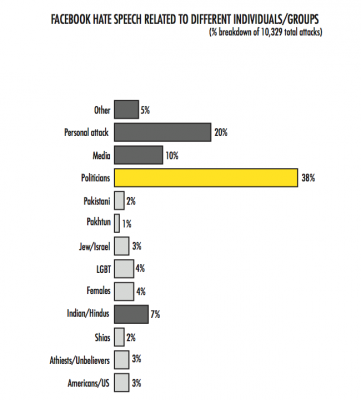
The two largest groups that were a target for hate speech on Facebook were politicians (38% of all hate speech) and members of the media/media groups (10%). These attacks on pillars of the state formed nearly half of all hate speech on the Facebook pages analyzed.Personal attacks formed another 20% of hate speech, while hate speech against Indians/Hindus formed 7% of the total.
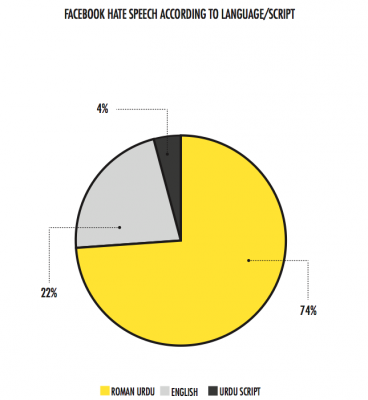
In terms of language, hate speech recorded on Facebook was largely in Roman Urdu (74%) followed by English (22%) and Urdu script (4%).
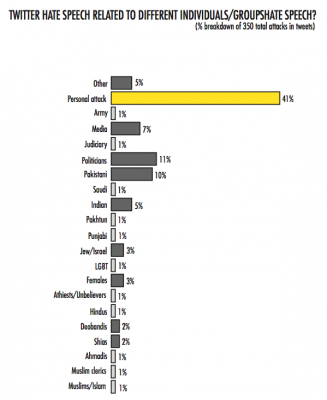
The majority of hate speech recorded on Twitter was personal attacks and abuse (41%). Other major targets included politicians (11%), Pakistanis (10%), media persons/groups (7%), and Indians/Hindus (6%). Total hate speech recorded on Twitter contained some attacks on Deobandis (2%), Shias (2%), Muslim clerics (1%) and general attacks on Muslims/Islam (1%).
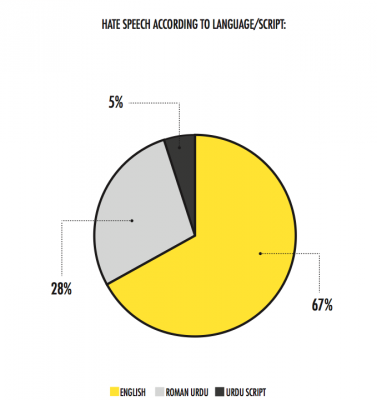
Hate speech collected on Twitter was largely in English (67%), followed by Roman Urdu (28%) and Urdu script (5%).